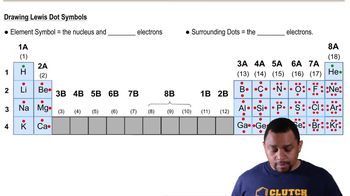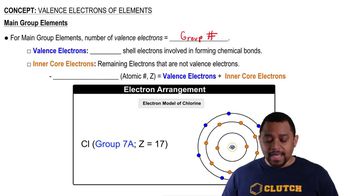Here are the essential concepts you must grasp in order to answer the question correctly.
Lewis Symbols
Lewis symbols, also known as Lewis dot diagrams, represent the valence electrons of an atom as dots surrounding the element's symbol. This visual representation helps in understanding how atoms bond with each other, as it shows the number of electrons available for bonding. For example, the Lewis symbol for calcium (Ca) would show two dots, indicating its two valence electrons.
Recommended video:
Lewis Dot Symbols (Simplified) Concept 2
Valence Electrons
Valence electrons are the electrons in the outermost shell of an atom and are crucial for chemical bonding. The number of valence electrons determines an element's reactivity and the types of bonds it can form. In the case of calcium, which is in group 2 of the periodic table, it has two valence electrons that it can lose to form ionic bonds.
Recommended video:
Valence Electrons of Elements (Simplified) Concept 1
Group Number
The group number in the periodic table indicates the number of valence electrons in the elements of that group. Elements in the same group share similar chemical properties due to their similar electron configurations. Calcium belongs to group 2, which signifies that it has two valence electrons, influencing its behavior in chemical reactions.
Recommended video:
Calculate Oxidation Numbers
 Verified step by step guidance
Verified step by step guidance Verified Solution
Verified Solution



 0:52m
0:52m